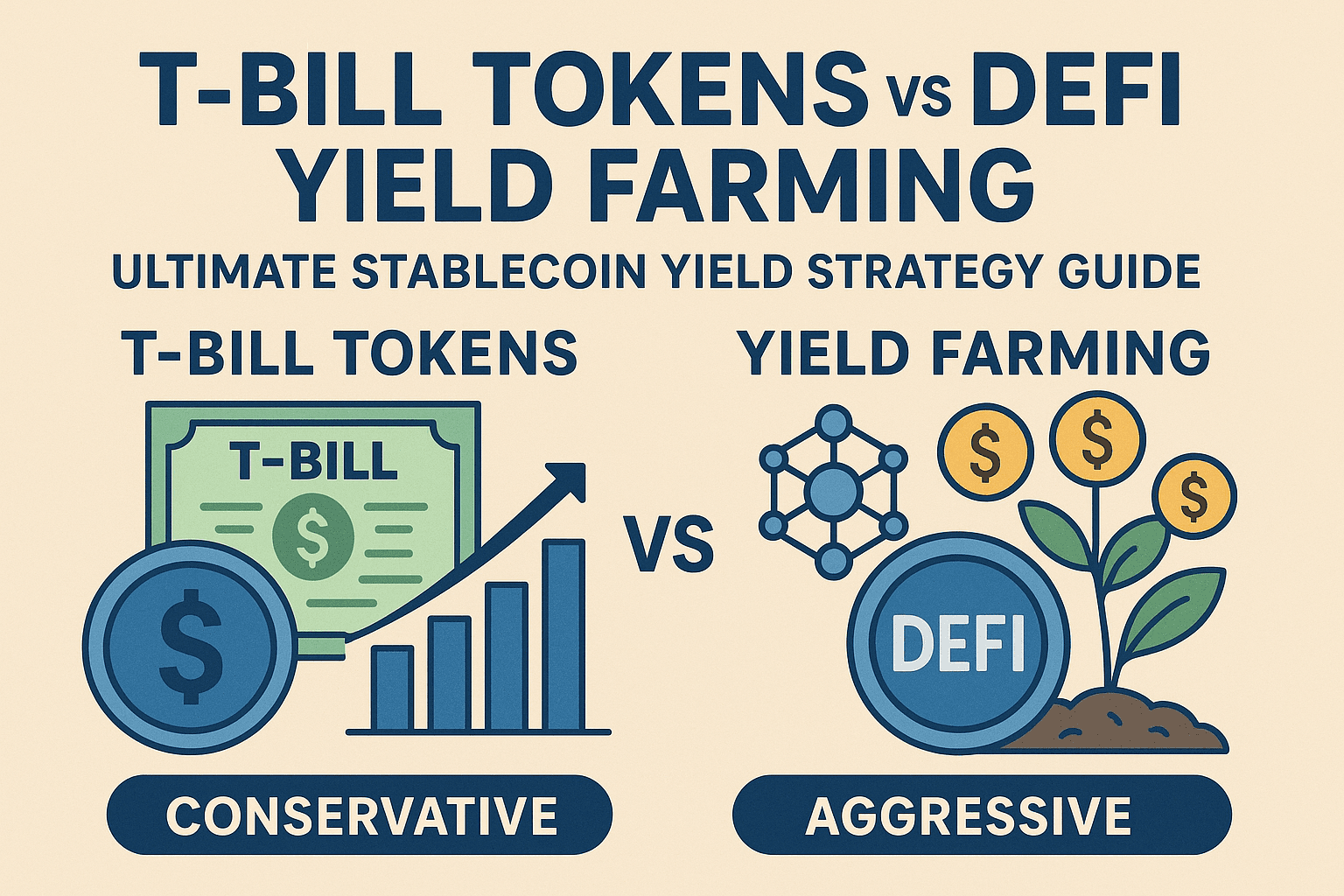Why T-Bill Tokens and Solana DeFi Are Dominating Stablecoin Yields
The Tokenized Treasury Revolution
Tokenized T-bills represent the biggest innovation in risk-free yield since government bonds went digital. BlackRock's BUIDL fund alone holds $2.9+ billion, offering institutional-grade 4.50% APY with the full faith and credit of the U.S. government backing every token.
Current Leading T-Bill Tokens (August 2025):
BlackRock BUIDL: 4.50% APY, $2.9B+ AUM, 0.20-0.50% management fees
Franklin Templeton BENJI: 4.2% APY, $750M AUM, ultra-low 0.15% fees
Ondo Finance USDY: 4.90% APY, $650M+ AUM, zero management fees
With 3-month Treasury bills yielding 4.24% as of August 2025, these tokenized versions offer competitive rates with 24/7 liquidity and blockchain programmability.
Solana DeFi: The High-Yield Frontier
Solana's ultra-low transaction costs and high throughput have created the most efficient DeFi ecosystem for yield farming. While Ethereum DeFi battles gas fees, Solana protocols can compound yields multiple times daily for pennies in transaction costs.
Top Solana Yield Farming Protocols (Current APYs):
marginfi: 35% APY on USDC deposits through high utilization lending
Kamino Finance: 24% APY base rates, up to 10-20% PYUSD rewards
Drift Protocol: 15% APY from trading fees and liquidation revenue
Save (formerly Solend): 2.5-12% APY depending on utilization
The massive yield differences come from Solana's unique position as the memecoin and high-frequency trading hub, creating enormous demand for leverage and borrowed stablecoins.
The Science of Yield Laddering: Risk Band Framework
Professional yield farmers don't just chase the highest APY—they build laddered portfolios that balance risk and return across multiple yield sources. Here's how to think about yield laddering by risk bands:
Ultra-Safe (0-2% Risk Premium): The Foundation
Tokenized T-bills (BUIDL, BENJI, USDY)
High-yield savings accounts
Money market funds
Target Yield: 4-5% APY
Conservative (2-5% Risk Premium): Steady Growth
Established Solana lending protocols (Save, established Kamino pools)
Blue-chip stablecoin liquidity pairs
Conservative yield aggregators
Target Yield: 6-8% APY
Balanced (5-10% Risk Premium): Growth Focus
Mixed T-bill/DeFi allocations
Cross-protocol yield optimization
Solana LST strategies combined with lending
Target Yield: 8-12% APY
Aggressive (10%+ Risk Premium): Maximum Yield
High-utilization lending (marginfi, high-demand Kamino pools)
New protocol incentives
Leveraged strategies
Target Yield: 12-25%+ APY
Conservative Yield Ladder: 5-7% Target APY (Sleep Well Strategy)
Perfect for: Risk-averse investors, retirees, treasury managers Time commitment: 30 minutes monthly Risk level: Very low
Portfolio Allocation:
50% Tokenized T-bills (USDY + BUIDL mix)
30% Conservative Solana DeFi (Save protocol)
20% Liquidity buffer (high-yield stablecoins)
Exact Implementation:
Foundation Layer (50%): Tokenized T-Bills
30% Ondo Finance USDY: Zero fees = maximum net yield at 4.90% APY
20% BlackRock BUIDL: Maximum institutional backing at 4.50% APY
Growth Layer (30%): Conservative Solana DeFi
20% Save protocol USDC lending: Battle-tested platform, 2.5-6% variable APY
10% Kamino Finance main pools: Automated liquidity management, 6-8% APY
Liquidity Layer (20%): Operational Flexibility
15% High-yield stablecoin accounts: Instant access for rebalancing
5% SOL for transaction fees: Keep small SOL balance for DeFi interactions
Management Strategy:
Weekly: Check protocol health and any major news
Monthly: Rebalance if allocations drift >5% from targets
Quarterly: Evaluate new tokenized T-bill products
Semi-annually: Review overall strategy performance
Expected Return: 5.5-6.5% APY
Maximum realistic downside: -2% in extreme DeFi protocol failure
Time to breakeven vs traditional savings: 6-12 months
Balanced Yield Ladder: 8-12% Target APY (Sweet Spot Strategy)
Perfect for: Experienced crypto investors, those with 2+ year time horizons Time commitment: 2-3 hours monthly Risk level: Moderate
Portfolio Allocation:
30% Tokenized T-bills (risk anchor)
50% Diversified Solana DeFi (core yield engine)
20% Tactical opportunities (alpha generation)
Exact Implementation:
Anchor Layer (30%): T-Bill Stability
30% USDY: Zero-fee yield-bearing foundation
Core Engine (50%): Multi-Protocol Solana DeFi
20% Kamino Finance diversified pools: Main USDC pools + JLP strategies (6-12% APY)
15% Save protocol: Established lending with good track record (4-8% APY)
15% Marinade mSOL strategies: Liquid staking + DeFi compounding (7-10% APY)
Alpha Generation (20%): Tactical Yield
10% Drift Protocol: Trading fee revenue from insurance fund (~15% APY)
10% New protocol incentives: Early PYUSD rewards, new Solana protocols
Advanced Techniques:
Cross-Protocol Yield Stacking: Use mSOL as collateral in lending protocols while earning staking rewards
Protocol Health Monitoring: Track TVL, utilization rates, and team activity across all protocols monthly
Yield Curve Trading: Shift allocations based on Solana DeFi utilization cycles and memecoin seasons
Expected Return: 9-11% APY Maximum realistic downside: -8% in broader DeFi downturn Optimal rebalancing frequency: Monthly with quarterly strategy reviews
Aggressive Yield Ladder: 15-25% Target APY (Maximum Alpha Strategy)
Perfect for: Experienced DeFi users, those comfortable with volatility, alpha seekers Time commitment: 5-10 hours monthly Risk level: High
Portfolio Allocation:
15% Tokenized T-bills (emergency anchor)
60% High-yield Solana protocols (primary engine)
25% Experimental strategies (maximum alpha)
Exact Implementation:
Anchor (15%): Minimal T-Bill Safety
15% USDY: Provides stability during DeFi volatility periods
Core Aggression (60%): High-Utilization Solana DeFi
25% marginfi high-utilization pools: Currently 35% APY on USDC through leverage demand
20% Kamino PYUSD incentive pools: 10-20% APY from protocol rewards
15% Drift Insurance Fund: ~15% APY from trading and liquidation fees
Maximum Alpha (25%): Experimental Edge
10% New Solana protocols: Early liquidity mining (50-200% APY short-term)
10% Leveraged yield strategies: Recursive borrowing/lending
5% Cross-DEX arbitrage: Jupiter aggregation + manual arbitrage opportunities
Risk Management Framework:
Position Limits: Never >10% in any single experimental protocol
Utilization Monitoring: Exit lending pools if utilization drops below 80%
Protocol Health Checks: Weekly TVL, social sentiment, and team activity monitoring
Stop-Loss Triggers: Automatic rebalancing if portfolio drops >15% month-over-month
Expected Return: 18-25% APY
Maximum realistic downside: -25% in protocol failures or exploit
Required expertise: Advanced DeFi knowledge, daily market monitoring
Advanced Yield Optimization Strategies
Dynamic Risk Adjustment
Market Condition Triggers:
Bull Market: Increase aggressive allocation to 35%, reduce T-bills to 10%
Bear Market: Increase T-bills to 60%, focus on proven protocols only
High Volatility: Shift to shorter-duration strategies, increase liquidity buffer
Cross-Protocol Yield Stacking
LST + Lending Combo: Stake SOL → Receive jitoSOL → Lend on Kamino → Earn staking + lending yields
Collateral Efficiency: Use USDY as collateral for borrowing while earning T-bill yields
Reward Token Management: Auto-compound protocol rewards or convert to stablecoins
Gas Optimization for Solana DeFi
Batch Transactions: Use Jupiter aggregation for multiple DeFi interactions
Timing Optimization: Compound during low network usage for minimal fees
Priority Fee Management: Use appropriate priority fees to ensure transaction success
The Programmable Yield Advantage
The complexity of managing positions across tokenized T-bills, multiple Solana protocols, and risk management creates significant operational overhead. This is where programmable infrastructure becomes crucial.
Manual Management Challenges:
Tracking yields across 5-10+ protocols
Rebalancing based on changing utilization rates
Managing liquidation risks in leveraged positions
Optimizing gas fees and transaction timing
Monitoring protocol health and security
Programmable Infrastructure Benefits:
Automated rebalancing based on pre-set risk parameters
Cross-protocol yield optimization without manual monitoring
Risk management automation with automatic position sizing
Gas optimization through intelligent batching and timing
The most successful yield farmers are increasingly using infrastructure that can programmatically manage these complexities, allowing them to capture alpha while maintaining proper risk management.
Implementation Roadmap: Your 90-Day Yield Strategy
Days 1-30: Foundation Phase
Week 1: Set up Solana wallet, acquire SOL for fees, establish first T-bill position (USDY)
Week 2: Create Save protocol lending position, begin learning Solana DeFi interfaces Week 3: Add Kamino Finance main pool exposure, set up yield tracking spreadsheet
Week 4: First rebalancing, evaluate performance vs. targets
Days 31-60: Growth Phase
Week 5-6: Add Drift protocol position (conservative allocation initially)
Week 7-8: Implement first cross-protocol strategy (LST + lending)
Week 9: Performance review, risk assessment, strategy adjustments
Days 61-90: Optimization Phase
Week 10-11: Add tactical opportunities (new protocols, higher-yield strategies)
Week 12: Full strategy review, long-term optimization planning
Week 13: Implement advanced techniques based on experience gained
Current Market Conditions and 2025 Outlook
Regulatory Tailwinds
The GENIUS Act signed in July 2025 provides clear regulatory framework for tokenized assets, driving institutional adoption. This regulatory clarity is boosting confidence in tokenized T-bills while creating separation between regulated and DeFi yields.
Solana Ecosystem Growth
Solana's dominance in memecoin trading and high-frequency DeFi has created unprecedented demand for borrowed stablecoins. This sustained demand supports the high yields in protocols like marginfi (35% APY) and Kamino's high-utilization pools.
Yield Sustainability Analysis
Sustainable: T-bill yields backed by U.S. government creditworthiness
Cyclical: Solana DeFi yields dependent on trading activity and leverage demand
Temporary: New protocol incentives typically last 3-6 months
Q4 2025 Predictions
T-bill tokenization market to reach $10B+ AUM
Solana DeFi yields to remain elevated during continued memecoin cycles
New yield sources from tokenized real-world assets beyond treasuries
Risk Management: Protecting Your Yield Strategy
Protocol-Specific Risks
Smart Contract Risk: Even audited protocols can have exploitable bugs
Regulatory Risk: DeFi protocols face uncertain regulatory landscape
Liquidity Risk: High-yield strategies may have withdrawal delays during stress
Mitigation Strategies
Diversification: Never exceed 25% allocation to any single protocol
Due Diligence: Research team, audits, TVL trends, and community sentiment
Exit Planning: Maintain 10-20% in liquid assets for quick rebalancing
Insurance and Protection
Protocol Insurance: Some Solana protocols offer insurance coverage
Risk Assessment Tools: Use platforms like DeFiSafety for protocol scoring
Community Monitoring: Active Discord/Twitter monitoring for protocol updates
Conclusion: Maximizing Your Stablecoin Yield in 2025
The convergence of tokenized T-bills and Solana DeFi protocols has created unprecedented opportunities for stablecoin yield generation. Whether you're targeting conservative 6% returns through T-bill heavy strategies or aggressive 20%+ yields through high-utilization DeFi lending, success comes from intelligent risk laddering and disciplined portfolio management.
Key Success Principles:
Start conservative, scale gradually - Build experience before increasing risk
Diversify across risk bands - Never concentrate in single yield sources
Monitor actively, rebalance systematically - Yields change rapidly in DeFi
Prioritize sustainability over peak APY - Consistent returns beat volatile spikes
The Bottom Line: The stablecoin yield landscape in 2025 offers genuine opportunities for earning 5-25% APY depending on risk tolerance. The key is building systematically, managing risk intelligently, and leveraging both the stability of tokenized T-bills and the innovation of Solana DeFi.
The future belongs to investors who can intelligently navigate both traditional finance innovation (T-bill tokens) and cutting-edge DeFi protocols. With proper strategy, risk management, and potentially programmable infrastructure to manage complexity, earning 10%+ annual yields on stablecoins is not just possible, it's becoming the new standard for sophisticated crypto investors.
Ready to start earning maximum yield on your stablecoins? Begin with our conservative strategy, master the fundamentals, then gradually scale into higher-yield opportunities as your experience and risk tolerance grow.



